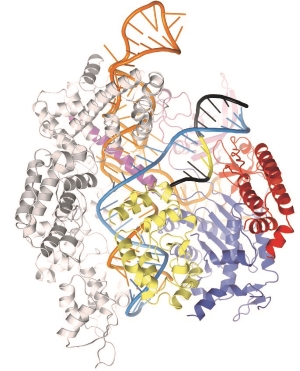Navigation auf uzh.ch
Navigation auf uzh.ch

RNA is an incredibly diverse and versatile molecule, capable of information storage, enzymatic catalysis and sequence-specific regulation. While messenger RNAs (mRNAs) function as carriers of genetic information for protein synthesis, non-coding RNAs act as molecular guides that target other nucleic acids through base pairing interactions and regulate their function. The discoveries of RNA-guided silencing mechanisms such as RNA interference in eukaryotes and the CRISPR-Cas pathway in bacteria and archaea have uncovered a previously hidden vast layer of regulatory complexity, underscoring the importance of RNA in shaping cellular function.
The Jinek group is interested in the role of RNA in controlling gene expression and genome defence. In particular, we focus on the molecular mechanisms of protein-RNA complexes and RNA-guided molecular machines.
Since 2012, our research has made fundamental contributions to our understanding of RNA-guided DNA targeting in prokaryotic CRISPR-Cas systems and directly led to the emergence of CRISPR-Cas genome editing technologies.
We are currently pursuing research projects aimed at obtaining structural and mechanistic insights into (i) Prokaryotic CRISPR-Cas systems and their applications as genome editing technologies, and (ii) RNA processing and modification pathways in eukaryotic post-transcriptional gene regulation.
In our studies, we combine structural methods (both cryo-EM and X-ray crystallography) with biochemical and biophysical approaches to analyze the molecular architecture and mechanisms of ribonucleoprotein complexes at the atomic level. Where possible, we strive to complement our in vitro work with cell-based functional assays that include CRISPR-Cas genome editing.
Our long-term goal is to advance our understanding of RNA-centred genome regulatory and defence mechanisms and their significance in the context of human health and disease. Moreover, insights gained from our work will continue to inform further development of RNA-directed genetic engineering applications and therapies.